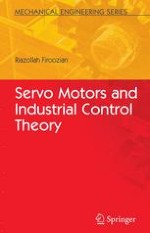2009 | Buch
Über dieses Buch
Servo Motors and Industrial Control Theory presents the fundamentals of servo motors and control theory in a manner that is accessible to undergraduate students, as well as practitioners who may need updated information on the subject. Graphical methods for classical control theory have been replaced with examples using mathematical software, such as MathCad and MatLab, to solve real-life engineering control problems. State variable feedback control theory, which is generally not introduced until the Masters level, is introduced clearly and simply for students to approach complicated problems and examples.
Anzeige
